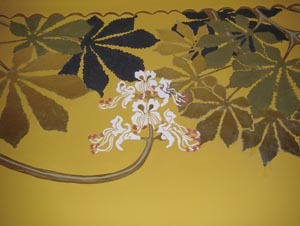As I spend much of my life in a flower bed, bottom up, I rarely consciously make the connection between the flowers that I grow in my garden and their more elevated associations, in particular their role in Christian art. Only when I visit art galleries or churches am I forcibly reminded that gardens and wild flowers appear again and again in paintings, as well as featuring prominently in the plastic and applied arts.
This is hardly surprising, since flowers were both comprehensible and universal symbols in preliterate times, and have remained enduring signs of Man’s appreciation of the beauty and variety of God’s creation. This was brought home to me the other week in Krakow in southern Poland, when I went to reacquaint myself with the Art Nouveau stained glass and murals of Stanislaw Wyspianski.
Wyspianski (1869–1907) is not a name to conjure with in this country, more’s the pity, except among his compatriots living here, of course. Where he is known, it is usually as the author of The Wedding, written in 1901, which earned him the reputation as the first modern Polish playwright. But Wyspianski, who was born and spent most of his short, illness-dogged life in Krakow, was much more than a prolific playwright: he was poet, city planner, furniture designer, illustrator, sculptor, printmaker and painter. He attained the Polish ideal of a deeply religious patriot, at a time when Krakow was part of Galicia, a province of Austria–Hungary. He was a prominent member of the Young Poland movement. This year, the centenary of his death, has seen a clutch of celebratory events in Krakow.
My Polish being still shamefully rudimentary, I couldn’t really join in with those, but I sought him out in the churches of central Krakow. He began his church work by helping to design the stained glass in the west end of the great St Mary’s Church, which dominates the Market Square. He also restored the stained glass in the nearby Dominican Church after the disastrous 1850 fire which swept through the middle of the city. However, his greatest achievements are the wall paintings (polychromes) and stained glass to be found in the Franciscan Church, close to where Pope John Paul II lived when he was Karol Wojtyla, Archbishop of Krakow.
The west end window is entirely taken up by an enormous and overwhelmingly powerful stained-glass image of God the Creator (‘Let it be’). On the side walls, however, are murals depicting some of His humblest creations, notably dandelions, sunflowers, and blue chicory, while cheerful pansies are painted entwined in a geometric grid, as if growing through a trellis. In the transept, there are bright orange and yellow nasturtiums, and beautiful pink and white roses. As the counterpoint to God the Creator, at the east end of the church, above the high altar, are six stained-glass windows. The two central ones encompass relatively small figures of the Blessed Salomea (an aristocrat who founded the church in the 13th century) dressed in the habit of the Poor Clare she became, and St Francis of Assisi. These figures are surrounded by summer flowers, especially graceful Madonna lilies, beautifully wrought. The other windows show the four elements, depicted by characteristically Art Nouveau flowers and sinuous abstract shapes. Most fascinating and beautiful for me are the images of tall mauve and purple Siberian irises, and dumpier yellow and white water lilies, set in swirling waters. Even on a gloomy day in November, they glow.
What touches me, as a gardener, about Wyspianski is that he took such care over the minute botanical exactitude of flowers in his murals and stained glass, while still managing to use them decoratively. This is true also of the work he carried out in the interior of the house owned by the Medical Society of Krakow (ul. Radziwillowska 4). Here, as well as a stained-glass window of Apollo, he designed metalwork balusters for the central staircase, in the shape of stylised horse-chestnut leaves and flowers, a design which he echoed in a painted ceiling frieze above (see picture).
A piece of the balustrading is on show in the Wyspianski Museum (ul. Szczepanska 11), where there are also the studies he made for the church murals and stained glass. When I was in Krakow, winter was tightening its grip on the city, snow was lying and temperatures were well below zero but, thanks to this remarkable man and the flowers he depicted, in the Museum and in the Franciscan Church at least, it is eternal summer.
Garden People: Valerie Finnis and the Golden Age of Gardening by Ursula Buchan (Thames and Hudson, £16.95) has been awarded the Enthusiasts’ Book of the Year by the Garden Writers’ Guild.






Comments